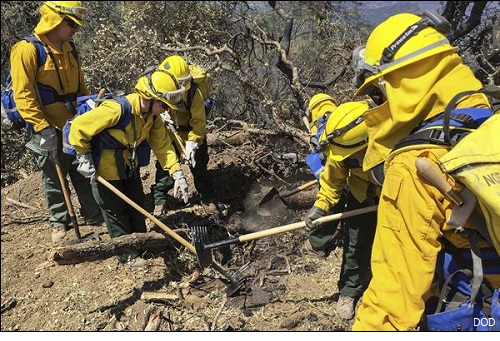
|
|

|
|
| April 19, 2024 |
|
National Guard to help with wildfire prevention efforts 
LOS ANGELES--California is preparing to mobilize National Guard troops to reduce the threat of wildfires by clearing hazardous dead trees, vegetation and creating fuel breaks, according to Cal Fire.
The fire agency has identified nearly three dozen priority projects in more than 200 communities around the state in areas considered high fire-risk zones. It comes as the state is bracing for perhaps another tough wildfire season after devastating 2017 and 2018 blazes that killed more than 120 people. Some of the National Guard troops set to help in the wildfire prevention efforts previously were focused on assisting in the Trump administration's U.S. border request. In February, California Gov. Gavin Newsom rebuked President Donald Trump's "manufactured crisis" at the border by announcing plans to pull more than 250 troops from the southern border. Last April, California's previous governor, Jerry Brown, agreed to send about 400 of the state's troops to the border at the request of Trump, who cited "a crisis" at the border due to a "combination of illegal drugs, dangerous gang activity, and extensive illegal immigration." "We're going to have [troops] spread out throughout the state to help us with the fuel reduction projects," said Cal Fire Deputy Chief Scott McLean. According to McLean, an initial 110 troops will start to get special training next month for their wildfire prevention assignments. The work includes prescribed burns, mechanical thinning of the forests and the creation of fire breaks. "It's not what they typically do," said McLean. "The governor has made it known that he is going to provide these troops to assist us in our work." In the past, the state has relied in part on assistance from inmate firefighters to clear brush and prepare for wildfire season. The state also uses inmates to battle fires as part of volunteer crews. State fire officials say current predictions are for the state's dry season this year to start in May. Many of the state's most destructive wildfires, though, have historically taken place later in the year after scorching summer temperatures dry grass and brush. This year's series of winter storms produced an abundance of grasses and other plant life in wildlands throughout the state, and that vegetation could add to the fire risk this summer and fall. In January, Newsom signed an executive order that directed the state's fire agency to prepare a plan with "immediate, medium-term, and long-term recommended actions that will have the greatest impact in preventing the impact of destructive, deadly fires." A key part of California's plan involves the National Guard helping to coordinate the fuel reduction operations statewide. More than 90,000 acres statewide are being targeted as part of the state's list of 35 priority fuel-reduction projects. Last year, California experienced more than 7,600 wildfires that charred more than 1.8 million acres, up from 1.3 million acres in 2017. Six of the 10 most destructive fires in the state have occurred in the past two years. The White House's proposed 2020 budget request calls for the U.S. Forest Service's total wildland fire activities to receive $2.35 billion, or an 18 percent decline, from the $2.88 billion estimated in 2019. The total amount reflects funding for preparedness and suppression activities. The state plans to get delivery of the first of a dozen new Black Hawk fire helicopters in May or June. Some of the fires detected by the current fire-spotting cameras have been extinguished using aerial equipment. (Source: CNBC) Story Date: March 26, 2019
|